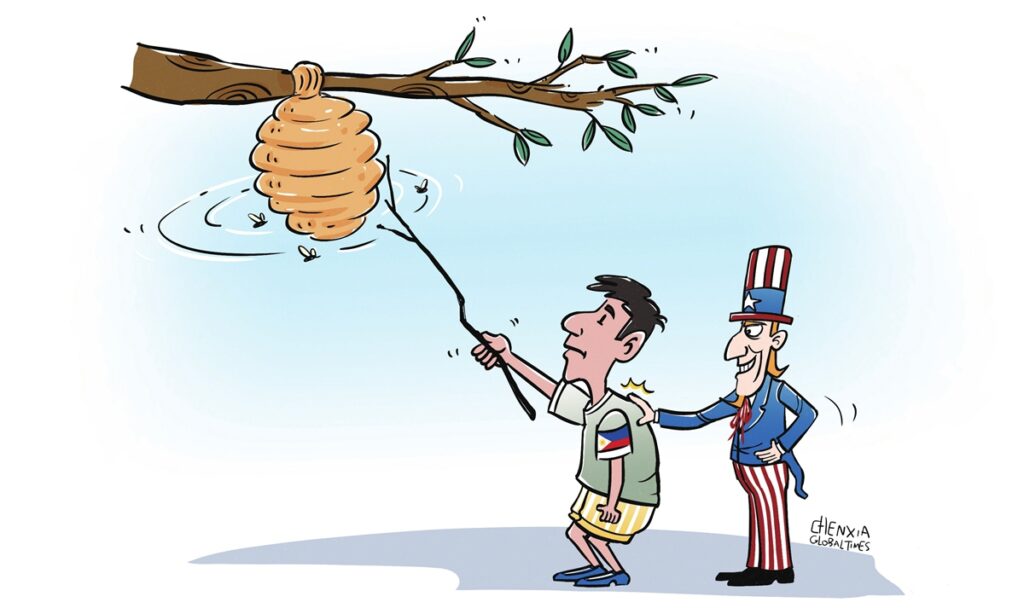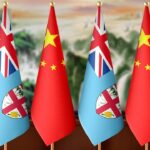On August 19, two Philippine coast guard vessels, despite China’s repeated dissuasion and warning, insisted on intruding into the adjacent waters of Xianbin Jiao (also known as Xianbin Reef) of China’s Nansha Qundao. One of the vessels even deliberately rammed the China Coast Guard (CCG) vessel that was carrying out law enforcement operation, and then intruded into the waters of Ren’ai Jiao (also known as Ren’ai Reef) with malicious intentions. In the face of the infringement by Philippine coast guard ships, the CCG monitored the entire process, effectively controlled the incident, and safeguarded rights in a professional, standardized, reasonable manner in accordance with the law. However, a maritime friction involving only China and the Philippines has aroused Washington’s “interest.” The US State Department issued a statement that day, saying it “stands with its ally the Philippines” and acted as the “world’s judge” across the Pacific, claiming that China’s actions were dangerous. What is even more provocative is that the statement also reiterated the 1951 US-Philippines Mutual Defense Treaty.
This is not the first time that this familiar move has appeared. In March, after the Philippines broke its promise and provoked China near Ren’ai Jiao, the US State Department issued a similar statement regarding the situation in the South China Sea, discrediting China’s policies and actions, and adding fuel to the flames. The Philippines’ repeated provocations were partly due to the instigation and “support” of the US, which have brought the situation in the South China Sea back to a tense atmosphere, and caused the possibility of more serious consequences.
The on-site video clips also show American journalists on board the Philippine Coast Guard ship, and this has been confirmed by the American media. The US sent reporters on board the ship in advance to collect materials and prepare a dirty bomb for public opinion. This undoubtedly proves that the cooperation between the US and the Philippines is quite close, not only in terms of military and politics, but also in terms of public opinion. This also further shows that the US is by no means simply “standing with its ally the Philippines” on the South China Sea issue, but is more likely to be the main driving force behind the incident.
This incident was less than a month after China and the Philippines reached a temporary arrangement on managing the situation of Ren’ai Jiao and cooled down the maritime disputes. What drove Manila to take another risk? The answer is obvious. On July 29, the “2+2” dialogue between US and Philippines’ top diplomats and defense chiefs held in Manila. Subsequently, the US announced that it would provide $500 million in foreign military financing to the Philippines. Ironically, this non-gratuitous financing will be used to build, develop and improve existing military bases in the Philippines that can be used by the US military. The US’ “speaking out” and actions often occur when the rational voices from the Philippines increase, causing external interference in the maritime frictions that should belong between China and the Philippines, and once again exposing the US’ intention to create a sustained tense situation in the South China Sea region.
In fact, the US, which is neither a party nor has the right to intervene, is impatiently expressing support, trying to meddle between China and the Philippines and discredit China. The intention is very obvious: on one hand, to continue to hype up the carefully crafted “China threat” rhetoric over the years, undermining the efforts of regional countries to establish problem-solving mechanisms through negotiation; on the other hand, to seize the opportunity to further expand military presence in the Asia-Pacific region and gain geopolitical advantages.
Some politicians in Manila willingly act as pawns for external forces, manipulating domestic public opinion and being aggressive in the South China Sea issue. They attempt to use the safety and interests of Filipino fishermen as bargaining chips for political gambling. Especially under the instigation of Washington, they want to replay the illegal arbitration and illegal occupation farce, which is extremely dangerous and short-sighted. Sacrificing their own country’s interests, they become a pawn used by other countries to contain China in terms of security, in exchange for empty promises. In the end, they will only end up losing everything.
China’s position and attitude in dealing with relevant issues are consistent and clear. On the premise of firmly safeguarding our territorial sovereignty and maritime rights and interests, we have always been committed to properly handling maritime disputes between China and the Philippines through dialogue and consultation. At the same time, some people in Manila should also keep their promises and return to abiding by the consensus and arrangements reached by China and the Philippines. Blind faith in the US-led alliance and so-called security guarantees in the region is not in line with the Philippines’ real interests. Only by respecting the Declaration on the Conduct of Parties in the South China Sea and stopping infringement on China’s territorial sovereignty and maritime rights and interests can the South China Sea issue be resolved constructively.
GT




